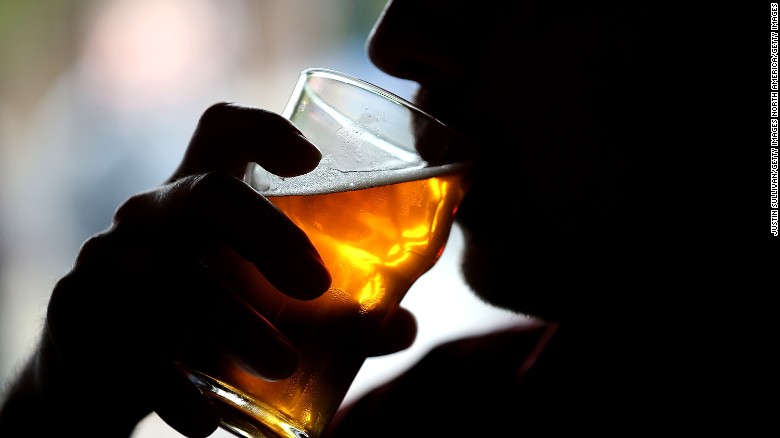(CNN)People around the world are increasingly bending their elbows. Between 1990 and 2017, per capita adult alcohol consumption increased by nearly 0.7 liters (about the same in quarts) to 6.5 liters (6.9 quarts) annually, new research indicates. The number is predicted to reach 7.6 liters (8 quarts) by 2030.
By 2030, then, half of the world's adults will drink (up from 45% in 1990), while 40% will abstain (down from 46% in 1990), according to the study published Tuesday in the journal The Lancet. Additionally, 23% of adults will binge drink at least once a month, compared with just 18.5% who did so in 1990. Binge drinkers are those who consume four standard drinks or more in one sitting at least once a month.
"Alcohol use has been increasing ... and alcohol use will seemingly continue to increase, despite the knowledge about consequence," J├╝rgen Rehm, study author, senior scientist and professor at the University of Toronto, wrote in an email. "This is clearly different than tobacco."
Alcohol consumption is known to cause or contribute to many diseases, including cancers, heart disease and diabetes. It can also lead to disability or death from both disease and injuries.
Europe sees a decrease in drinking
The new study measured per capita alcohol consumption in 189 countries between 1990 and 2017. Before 1990, most alcohol was consumed in high-income countries, and the highest levels were reported in Europe. However, this pattern has changed substantially over time.
Alcohol use decreased in most European countries between 2010 and 2017. For example, the researchers recorded a 22% yearly per capita decrease in Russia, from 15.8 liters (16.7 quarts) to 12.3 liters (13 quarts), while the United Kingdom registered a 7.4% decrease from 12.3 (13 quarts) to 11.4 liters (12 quarts). (The study defines "adults" as people 15 or older and uses the World Health Organization's classification system, so "Europe" includes Eurasian nations.)
The most notable decrease during the same period was seen in Azerbaijan, with an 82% decrease from 2.9 liters (3.1 quarts) in 2000 to just 0.5 liters (about 0.5 quarts) in 2017.
The new report did not investigate the reasons behind the changing trends. However, the authors note that "many factors affect the level of alcohol use," and three stand out as most important: economic wealth, religion and the implementation of alcohol policies. The authors note that some European nations, including Russia, have recently introduced policies to prevent overuse of alcohol.
Asia experiences an increase in drinking
Significant increases in per-capita alcohol consumption were recorded in southeast Asian and western Pacific countries between 2010 and 2017, the researchers say.
India saw a 38% increase, from 4.3 to 5.9 liters (4.5 to 6.2 quarts). A 90% increase, from 4.7 to 8.9 liters (5 to 9.4 quarts), was seen in Vietnam, where 2017 per capita levels were higher than in some European nations, such as Italy (7.4 liters or 7.8 quarts) and the former Yugoslavia (7.8 liters or 8.2 quarts).
These increases suggest that by 2030, Europe will no longer have the highest level of alcohol use, while southeast Asian and western Pacific nations will drive the rise in global consumption, the authors say.
"The forecasted global increase in alcohol use can be attributed to increases in economic wealth in low-income and middle-income countries, which was one of the predictors of our model," the authors wrote.
Take China, which in 1990 reported more abstainers than drinkers and a small proportion of bingers (49%, 48% and 16%, respectively). By comparison, only 30% of Chinese abstained in 2017, while 67% drank and 30% binged; by 2030, China is expected to host 20% abstainers, 77% drinkers and 40% bingers.
Trends in the Americas
Compared with Europe and Asia, shifts in alcohol trends appear modest in the United States.
Between 2010 and 2017, for example, there was an annual per capita increase of less than 6%, from 9.3 liters (9.8 quarts) to 9.8 liters (10.4 quarts), the study showed. During the same period, the proportion of lifetime abstainers dropped from 12% to 11%, while drinkers increased from 72% to 73% and binge drinkers decreased 2 percentage points to 27%.
Meanwhile, some South American nations reported decreases in adult per capita consumption between 2010 and 2017. Most notably, Peru recorded a 24% decline from 8 liters (8.5 quarts) to 6.1 liters (6.4 quarts).
Three trends to watch
Moving forward, the volume of alcohol consumed is projected to grow faster than the number of people who drink. Specifically, the researchers expect a 17.8% increase in volume around the globe, while those imbibing are expected to increase by just 5% between 2018 and 2030.
Additionally, the prevalence of binge drinking is projected to swell over time, reaching 23% in 2030, up from 20% in 2017. This growing proportion of bingeing will increase the amount of alcohol-related disease, the researchers note.
Finally, the gap between male and female drinkers will decrease, the researchers predict, due in part to women getting paid for their work.
"Alcohol is a luxury good, which is not necessary for survival or well-being," Rehm explained. Earn disposable income, though, and "alcohol becomes an option."
Grain of salt
Sarah Callinan, a research fellow at La Trobe University's Centre for Alcohol Policy Research in Australia, said in a commentary published alongside the study that economic projections "are themselves uncertain," so the findings should be "treated with some caution."
Policies intended to reduce the harms of alcohol use are "crucial, particularly in low-income and middle-income countries," she said.
Which policies work? Increasing price and restricting availability have proved effective in high-income countries, but they may be less so in lower-middle-income countries, where more than half of alcohol consumption is unrecorded, she noted.
"Strict restrictions on advertising and other promotional activities are crucial to slow the growing demand for alcohol," she wrote. "Similarly, rigorous [drunken driving] countermeasures are necessary so that increasing consumption does not lead to increases in road traffic injury."
Get CNN Health's weekly newsletter
Sign up here to get The Results Are In with Dr. Sanjay Gupta every Tuesday from the CNN Health team.
Rehm agrees that policy is an effective tool for reducing consumption. He also emphasized the fact that Americans are experiencing a stagnation or even slight decline in their life expectancy.
"Alcohol plays a role there," he said. Implementing alcohol control policies, then, might increase how long people live in the United States, "where a majority uses alcohol, and where the level of consumption is markedly above the global average!"






